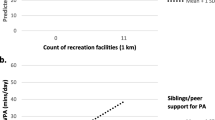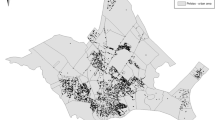Abstract
Objective
A child’s opportunity for physical activity and the safety of engaging in activity are influenced by built environment (BE) elements. This study examined the relationship of neighbourhood type and socio-economic status (SES) with activity using a sampling frame that purposely located schools in varying neighbourhoods to ensure that there was variability in BE characteristics and SES.
Methods
Participants (1,027 Grade 5 & 6 students, Toronto, ON) were drawn from 16 schools that varied by neighbourhood type (pre-1946 “old/urban BE” with grid-based street layout versus post-1946 “new/inner-suburban BE” with looping street layout) and socio-economic status (low and high SES). Physical activity was recorded by accelerometry for seven days. Only children living within 1.6 km of school were included in the analyses (n=713; boys=339, girls=374). Generalized linear mixed models examined sex-specific differences in physical activity across four geographic stratifications: old BE, low-SES (OL); old BE, high-SES (OH); new BE, low-SES (NL); and new BE, high-SES (NH).
Results
Children who attended schools in more affluent neighbourhoods (urban and inner-suburban) had more positive physical activity profiles. Across school days, boys were more active in inner-suburban neighbourhoods whereas urban and inner-suburban girls’ activity levels were similar. On the weekend, the influence of the neighbourhood environment was stronger, especially for girls and also for boys with respect to total activity and the accumulation of moderate-to-vigorous physical activity.
Conclusion
These findings focus attention on the need to consider the broader social and temporal contexts of specific geographic locations when planning and implementing built environment interventions to increase physical activity among children.
Résumé
Objectif
Les occasions pour un enfant de faire de l’activité physique et la possibilité de le faire en toute sécurité sont influencées par les éléments du milieu bâti (MB). Notre étude porte sur la relation entre le type de quartier, le statut socioéconomique (SSE) et l’activité; la base d’échantillonnage utilisée contenait volontairement des écoles de divers quartiers pour assurer la variabilité des caractéristiques du MB et du SSE.
Méthode
Les participants (1 027 élèves de 5e et de 6e année à Toronto, en Ontario) ont été choisis dans 16 écoles qui variaient selon le type de quartier («MB ancien/urbain» d’avant 1946 avec rues quadrillées ou «MB nouveau/de la proche banlieue» d’après 1946 avec rues en boucles) et le statut socioéconomique (SSE faible ou élevé). L’activité physique a été enregistrée par accélérométrie pendant sept jours. Seuls les enfants vivant à moins de 1,6 km de l’école ont été inclus dans l’analyse (n=71 3; garçons=339, filles=374). Au moyen de modèles linéaires mixtes généralisés, nous avons examiné les différences par sexe dans l’activité physique entre quatre stratifications géographiques: MB ancien, faible SSE; MB ancien, SSE élevé; MB nouveau, faible SSE; et MB nouveau, SSE élevé.
Résultats
Les enfants qui fréquentaient les écoles des quartiers aisés (urbains et de la proche banlieue) avaient des profils d’activité physique plus positifs. Les jours d’école, les garçons des quartiers de la proche banlieue étaient plus actifs, tandis que les niveaux d’activité des filles étaient semblables en milieu urbain et dans la proche banlieue. Les fins de semaine, l’influence de l’environnement du quartier était plus forte, surtout chez les filles, mais aussi chez les garçons en ce qui a trait à l’activité totale et à l’accumulation d’activité physique modérée à vigoureuse.
Conclusion
Ces résultats montrent qu’il faut examiner le contexte social et temporel des lieux géographiques lorsqu’on planifie et que l’on met en œuvre des interventions sur le milieu bâti pour accroître l’activité physique chez les enfants.
Similar content being viewed by others
References
Frank LD, Schmidt TL, Sallis JF, Chapman J. Linking objectively measured physical activity with objectively measured urban form: Findings from SMARTRAQ. Am J Prev Med 2005;28:117–25.
Davison K, Lawson CT. Do attributes in the physical environment influence children’s physical activity? A review of the literature. Int J Behav Nutr Phys Act 2006;3:19 (doi:10.1186/1479-5868-3-19).
Rahman T, Cushing R, Jackson RJ. Contributions of built environment to childhood obesity. Mt Sinai J Med 2011;78:49–57.
Sandercock G, Angus C, Barton J. Physical activity levels of children living in different built environments. Prev Med 2010;50:193–98.
Pate RR, Freedson PS, Sallis JF, Taylor WC, Sirard J, Trost SG, Dowda M. Compliance with physical activity guidelines: Prevalence in a population of children and youth. Ann Epidemiol 2002;12:303–8.
Loucaides CA, Chedzoy SM, Bennett N. Differences in physical activity levels between urban and rural school children in Cyprus. Health Educ Res 2004;19:138–47.
Tremblay MS, Barnes JD, Copeland JL, Esliger DW. Conquering childhood inactivity: Is the answer in the past? Med Sci Sports Exerc 2005;37:1187–94.
Drenowatz C, Eisenmann J, Pfeiffer K, Welk G, Heelan K, Gentile D, Walsh D. Influence of socio-economic status on habitual physical activity and sedentary behavior in 8- to 11-year old children. BMC Public Health 2010;10:214. Available at: https://doi.org/www.biomedcentral.com/1471-2458/10/214 (Accessed October 5, 2011).
Ferreira I, Horst K van der, Wendel-Vos W, Kremers S, van Lenthe FJ, Brug J. Environmental correlates of physical activity in youth — a review and update. Obes Rev 2007;8:129–54.
Maher CA, Olds CS. Minutes, MET-minutes, and METs: Unpacking socioeconomic gradients in physical activity in adolescents. J Epidemiol Community Health 2011;65:160–65.
Colley R, Garriguet D, Janssen I, Craig CL, Clarke J, Tremblay MS. Physical activity of Canadian children and youth: Accelerometer results from the 2007 to 2009 Canadian Health Measures Survey. Health Reports (Statistics Canada, 82-003) 2011;22:1–10.
Hess PM. Avenues or arterials: The struggle to change street building practices in Toronto, Canada. J Urban Design 2009;14:1–28.
Sewell J. Don Mills: Canada’s first corporate suburb. In: Sewell J, The Shape of the City: Toronto Struggles with Modern Planning. Toronto, ON: University of Toronto Press, 1993; chapter 3.
Mitra R, Buliung RN. Built environment correlates of active school transportation: Neighbourhood and the modifiable areal unit problem. J Transport Geography 2012;20:51–61.
Cole TJ, Bellizzi MC, Flegal KM, Dietz WH. Establishing a standard definition for child overweight and obesity worldwide: International survey. BMJ 2000;320:1240.
Stone MR, Rowlands AV, Middlebrooke AR, Jawis MN, Eston RG. The pattern of physical activity in relation to health outcomes in boys. Int J Pediatr Obes 2009;4:306–15.
Stone MR, Rowlands AV, Eston RG. Characteristics of the activity pattern in normal weight and overweight boys. Prev Med 2009;49:205–8.
Stone MR, Rowlands AV, Eston RG. Relationships between accelerometer-assessed physical activity and health in children: Impact of the activity-intensity classification method. J Sports Sci Med 2009;8:136–43.
Oliver LN, Hayes MV. Neighbourhood socio-economic status and the prevalence of overweight Canadian children and youth. Can J Public Health 2005;96:415–20.
Veugelers P, Sithole F, Zhang S, Muhajarine N. Neighborhood characteristics in relation to diet, physical activity and overweight of Canadian children. Int J Pediatr Obes 2008;3:152–59.
Moore LV, Diez Roux AV, Evenson KR, McGinn AP, Brines SJ. Availability of recreational resources in minority and low socioeconomic status areas. Am J Prev Med 2008;34:16–22.
Veitch J, Bagley S, Ball K, Salmon J. Where do children usually play? A qualitative study of parents’ perceptions of influences on children’s active free-play. Health & Place 2006;12:383–93.
Mitra R, Buliung RN, Faulkner G. Spatial clustering and temporal mobility of walking school trips in the Greater Toronto Area, Canada. Health & Place 2010;6:646–55.
Page AS, Cooper AR, Griew P, Davis L, Hillsdon M. Independent mobility in relation to weekday and weekend physical activity in children aged 10–11 years: The PEACH Project. Int J Behav Nutr Phys Act 2009 Jan 7;6:2.
Bailey RC, Olson J, Pepper SL, Porszasz J, Barstow TJ, Cooper DM. The level and tempo of children’s physical activities: An observational study. Med Sci Sports Exerc 1995;27:1033–41.
Stone MR, Rowlands AV, Eston RG. The use of high-frequency accelerometry monitoring to assess and interpret children’s activity patterns. In: Jurimaë T, Armstrong N, Jürimaë J (Eds.), Children and Exercise XXIV. London: Routledge, 2008;150–53.
Mitra R, Buliung RN, Roorda MJ. The built environment and school travel mode choice in Toronto, Canada. Transportation Research Record 2010;2156:2150–59.
Author information
Authors and Affiliations
Corresponding author
Additional information
Acknowledgements: This research was funded by the Built Environment, Obesity and Health Strategic Initiative of the Heart and Stroke Foundation and the Canadian Institutes of Health Research
Conflict of Interest: None to declare
Rights and permissions
About this article
Cite this article
Stone, M.R., Faulkner, G.E., Mitra, R. et al. Physical Activity Patterns of Children in Toronto: The Relative Role of Neighbourhood Type and Socio-economic Status. Can J Public Health 103 (Suppl 3), S9–S14 (2012). https://doi.org/10.1007/BF03403829
Published:
Issue Date:
DOI: https://doi.org/10.1007/BF03403829




